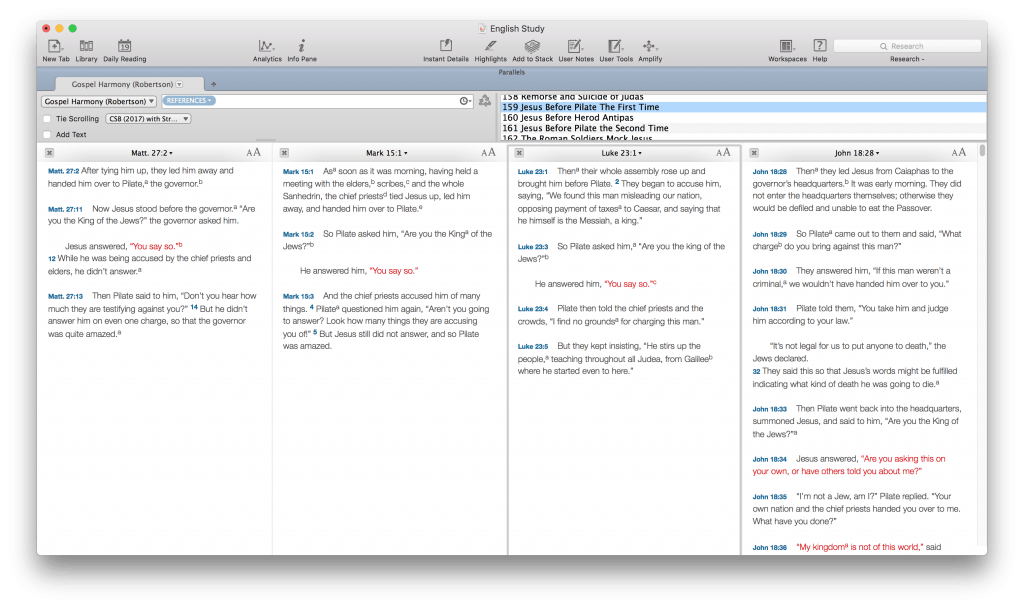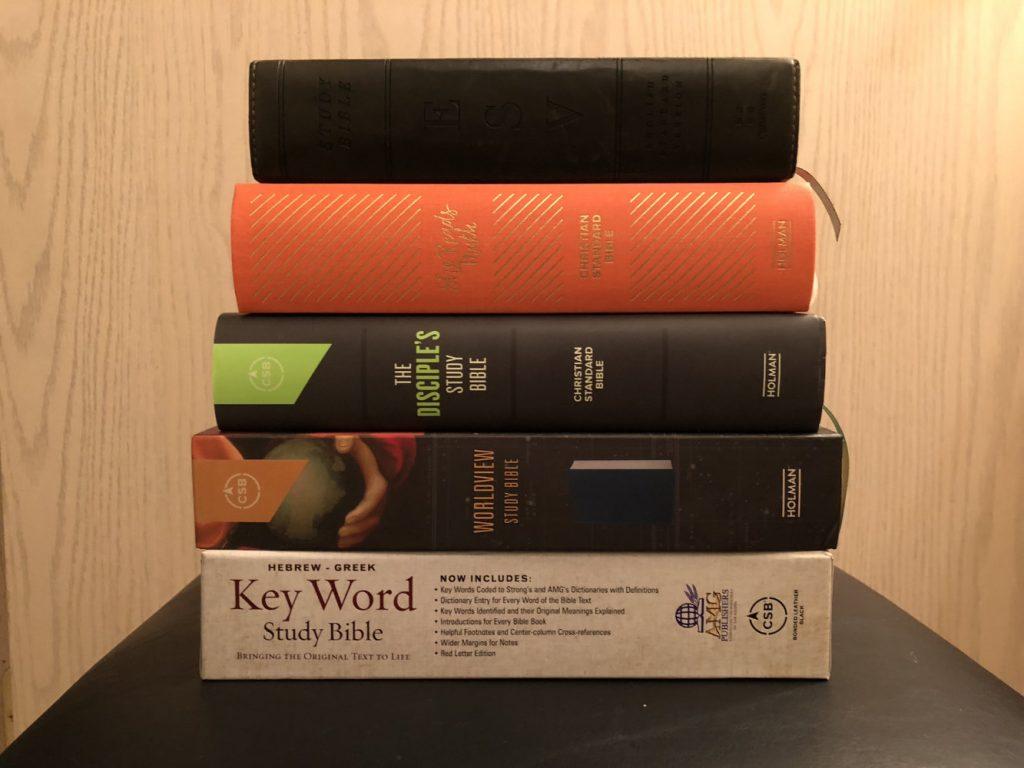When we become a Christian, one of the first books of the Bible we’re told to read is a gospel. The gospels teach us about the life and ministry of Jesus. But, as you read them individually you begin to notice differences between them. The timelines appear different, and each author highlights some events over others. The question then becomes, how do you piece together the gospel narrative? What’s the order of all the events? This is where a tool called a gospel harmony comes to the rescue.
This week we’re looking at the in’s & out’s of gospel harmonies and how to get the most out of them in your Bible study.
Why Four Gospels?
Have you ever wondered why God included four different accounts of Jesus’ life and ministry in the Bible? Wouldn’t one, or maybe two, suffice? When you give it some thought, the answer is no. When it comes to determining truth, especially in a court of law, we want as many eyewitness testimonies as possible. We want to corroborate the evidence and draw conclusions based upon the evidence. God’s gift of four gospels allows us to do just that.
The beauty of the gospels is that each tells us about Jesus, but from a perspective unique to each author. Sure, they mention some of the same events, but they emphasize different aspects based on the evidence required by their respective audience. And, that is key, each gospel author wrote with a specific audience in view. Matthew wrote his gospel for skeptic Jews, proving how Jesus is their long awaited Messiah. Yet Luke and Mark, on the other hand, wrote to Gentile audiences.
Gospels give us testimonies of Jesus' life and ministry. Share on XTaken individually, each gospel does a great job of telling us who Jesus is and what he did. But, taken together, the four gospels paint a vivid and holistic picture of Jesus as the Son of God who died for our sins.
But, the problem with four gospels written at different times for varying audiences and different reasons is this: making sense of how everything connects on a timeline. This is where a gospel harmony is useful.
What is a Gospel Harmony?
So, a gospel harmony is useful for making sense of the gospels’ interconnectedness, but what is it? At its simplest, a gospel harmony is an attempt to put each event in the four gospels in chronological order. With this, it finds the overlapping events in the gospels and puts them together.
A gospel harmony can be displayed in a variety of formats. Let’s briefly take a look at each one.
Diatessaron
One of the first and earliest attempts at harmonizing the gospels came in the Second Century (around 160-175 AD) and is called the Diatessaron. Tatian, a Christian and disciple of Justin Martyr, was the mastermind who put this first gospel harmony together. The idea came to him after hearing Justin read from the gospels each Sunday and noticing how he harmonized the various gospel accounts. At this, he undertook the process of combining the four gospels into a single coherent narrative text. This text became the gospel text for liturgical use in the Syrian church for more than two decades, and has been the base for numerous derivative works throughout Church history.
The Diatessaron is the reason we have modern gospel harmonies. Even today, we can still find modern Diatessaron works using modern Bible translations. One such modern attempt is George Knight’s A Simplified Harmony of the Gospels.
Tatian's Diatessaron is the first gospel harmony, which created a single gospel narrative Share on XTable Format
In modern times, authors of gospel harmonies aren’t necessarily trying to create a single gospel narrative. Instead, their goal is aligning the gospel accounts in such a way that Christians can easily reference the information and make sense of the gospel chronology. Therefore, the method of choice has been the creation of tables that align the various gospel accounts next to one another. Often times, they will create a pericope heading and then list each gospel passage in one of four columns.
This method allows us to quickly glance at a table and see which events appear in which gospel. With a scan we can see if something is unique to John’s gospel, or if it appears in only Matthew and Luke.
These tables can be found in many places. They are readily available online. we can also find them in the back of many study Bibles or Bible handbooks. And a good Bible software package will also make one available.
Parallel Bible Text
While a tabular gospel harmony is something you might find tucked away in something like a study Bible, Christian publishers and Bible software companies have found other ways to present the data. One of the more popular ways to present the data is using parallel columns of Bible text. Now, instead of having the verse references side-by-side for comparison, we have the full Bible text to read in parallel.
Such a method allows us to easily read the details of each gospel account without the need to flip back & forth, or using multiple Bibles. Additionally, the task of comparing and contrasting the details is much easier when the passages are presented in parallel.
One edition that does a great job of presenting a parallel Bible text is the CSB Christ Chronological, which lays out the data in parallel, while also color coding each gospel text and providing commentary. Parallel gospel harmonies are also a product or feature found in most Bible software packages, such as Olive Tree or Logos.
How to Use a Gospel Harmony in Your Studies
Now that we know what a gospel harmony is, let’s talk about how they are useful for Bible study.
1) Read the Gospels
The first way to get the most out of a gospel harmony is using it for what it was designed to do: reading the gospels. Find a gospel harmony and take your time reading through the gospels in chronological order. Enjoy the process of reading an event in Matthew, and then reading the parallel account in Luke. If you have never read the gospels chronologically, this is a great way to read them. It makes it so easy to see the timeline of events and how everything lines up.
Often times when I read through the Bible, I alternate between reading the gospels straight through and using a harmony to read them. I also know some people who read the gospels daily and do similarly so that it keeps their reading from becoming monotonous.
One of the best ways to use a gospel harmony is to use it to read the gospels Share on X2) Study the Similarities and Differences
As you read the gospels with a harmony, you begin to notice differences between each gospel author. You will notice their language, how they cover events, the order in which they’re covered, and so on. For example Matthew uses the phrase “kingdom of heaven,” whereas Luke uses “kingdom of God” instead. A quick study will show that this is primarily due to the audience they wrote to. Another example is how only Luke covers Jesus being sent to Herod, whereas the other three gospels only speak of his time before Pilate before his crucifixion.
So, take time to notice such details as you work your way through the gospels. Not only will it enhance your studies, but it will increase your knowledge of each gospel and Jesus’ earthly ministry.
3) Use It as a Cross-Reference
Even if you’re focusing on a specific gospel in your studies a gospel harmony can still prove useful. This time, instead of using it to read through each gospel, you can use the harmony as a cross-reference tool. Know where to look for parallel passages in the other gospels to use for comparison. It will also help you find events that are not covered in the gospel you’re studying. The side-by-side nature of a harmony means you can get this information at a glance without the need of sifting through your other cross-references, which you would use later in your studies.
4) Compare Harmonies
Lastly, you can compare different gospel harmonies. We do not have an exact timeline of when certain events happened in each gospel, so each author is giving it his best shot when aligning the data to create his or her harmony. This means each author uses a different set of criteria to filter and prepare their data; which, in turn, means there are differences between each gospel harmony you find.
Knowing this, use your studies as an opportunity to compare & contrast the different harmonies to piece together the chronology of Jesus’ life. The experience can be fun and you will walk away with a greater appreciation for how these harmonies are created.
Gospel Harmony Resources
Listed below are a handful of my favorite gospel harmony resources. Some are standalone products, while others are encompassed in other resources.
Paid Resources
- A Simplified Harmony of the Gospels
- CSB Christ Chronological
- CSB Disciple’s Study Bible (contains a gospel harmony table in the back)
- Harmony of the Gospel – Olive Tree Bible Software
- Parallel Gospel Reader – Logos Bible Software
Free Resources
Conclusion
As you can see, gospel harmonies can bring a level of harmony to your study of Jesus’ life and ministry. Find a gospel harmony and use it to start making your way through the gospels.
Have you used gospel harmonies before? If so, what are some of your favorites?
Weekly Study Prompts
This week, meditate and journal on the following passages:
- Monday – John 6
- Tuesday – Matthew 19:16-30
- Wednesday – Luke 15-16
- Thursday – Luke 17:11-37; 18
- Friday – Mark 10
- Memory Verses: Mark 10:45; John 6:37
Free Bible Study eBook
Click the button below to get a free copy of our "Bible Study Blitz" ebook that will give you 5 tips to enhance your Bible study.






